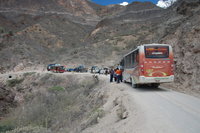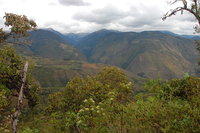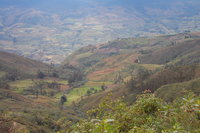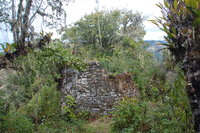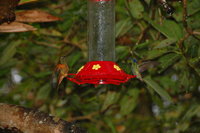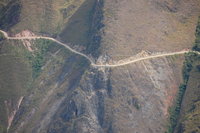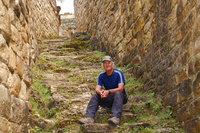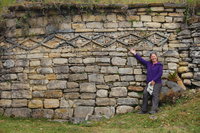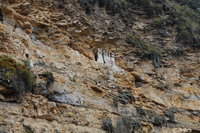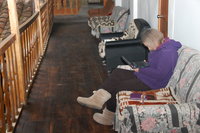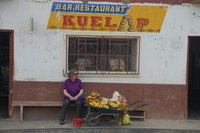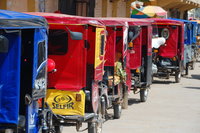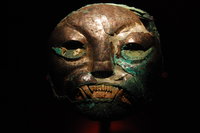It's mainly about old Peruvian civilisations this time, so sorry if that is not your bag.
We left Trujillo after the independence festival and continued our push north into areas less frequented by gringos. Our reason for heading up to the north was to see pre-Incan ruins, some of which we have already written about. However, to the north and east of Trujillo, there is an area replete with ruins. It's in the northern Andes and quite difficult to access. In fact, our guide book specifically advises against the route we had planned...so we set off anyway!
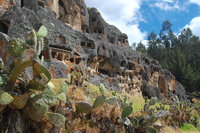
A seven hour bus trip took us north and east into the northern highlands and the town of Cajamarca. It is well known (locally) as the place where the Inca ruler Atahualpa was captured by the Spaniards and executed in 1533 after he had paid them a massive ransom in gold to buy his freedom. It is also famous nowadays for gold mining, the surrounding hills are stuffed with it. However, it's not in nugget form and has to be extracted chemically from the rocks. This process uses a lot of water that the surrounding inhabitants could usefully employ for trivial purposes like drinking and washing - sucks to be a local!. Much friction has been caused, there have been strikes and aggression. A state of emergency was declared in the latter half of 2012, but things seemed fairly quiet (figuratively speaking) whilst we were there.
Outside Cajamarca are some pre-Incan necropolises. We visited the one at Otuzco which contains funerary niches carved into the rocky hillside. They look like windows in the rock face and are known as the Ventanillas de Otuzco. They would have contained mummified remains, but were all plundered many years ago. It is thought that they date from somewhere between 1100BC and 1100AD, which gives the archaeologists quite a bit of wiggle room! We skipped the organised tours and took a collectivo for virtually nothing that dropped us at the door. We had just finished looking at the Ventanillas when all the tour coaches arrived - result.
Things started to get a bit dicey at this point as we embarked on the trans-Andean journey towards Chachapoyas. We decided to break the journey at Celendín which turned out to be just as well. We ended up on a bus operated by a company called "Royal Palace's" (sic). The route goes up out of Cajamarca to a high mountain pass before plummeting down into Celendín on moderately terrifying narrow mountain roads. To cap it all there were roadworks seemingly designed to make the road even narrower. At one point, we sat for about 10 mins canted at a weird angle whilst the driver decided whether it was physically possible to proceed without parting company with the scenery and taking the quick way down.
We knew that there was a festival in Celendín as we had seen adverts for the bull fighting, but we couldn't get there in time. We arrived on the afternoon of the last day of the festival. The town seemed very quiet and the plaza was deserted, so we had no qualms about checking in to a hotel right on the corner. Of course, as soon as we had checked in, the bull fighting ended, the entire town descended on the plaza and the closing festivities began. They did not end until the following morning. In fact some hardy types were still drinking as we departed (now very tired) to find the next death bus...
Our guide book advises taking food, water and valium for this trip. It also advises which side of the bus is the least nauseating in terms of the precipitous views. We sat on the nauseating side of the "Virgen del Carmen" bus! What the guide book does not tell you is that the bus company takes your finger prints before you board the bus! We can only speculate as to why. There is not much to say about this journey other than that it starts at Celendín at 2625m, ascends to 3085m before dropping down a vertical cliff face to Balsas at 975m. Just when you think it's safe to breath again, it immediately ascends to Black Mud Pass at 3678m before immediately hurtling back down the 3.5 vertical km to Leimebamba. The journey was advertised as taking somewhere between 4 and 6 hours. However, at the top of Black Mud Pass, a sign informed us that the road was closed until 5pm for roadworks. It was now 3pm! However, for some inexplicable reason, the Peruvians got their act together, the road was opened early and we were able to proceed. The entire journey ended up being 7 hours of unadulterated terror! Steve has often wondered why they don't show Airplane on in-flight entertainment. This bus showed Journey to the Center of the Earth on the video. There are many scenes of rocks falling and people hurtling, screaming downwards. When you press your face to the bus window and still can't see the edge of the road and it's 3.5km straight down, such films are not reassuring. The Death Road in Bolivia seemed bad at the time, but this is much, much worse. We guess these roads are not judged more dangerous as there are fewer accidents (since no one uses them). There are no photos of the "views" on this journey as we were too busy clinging to the bus to operate the camera.
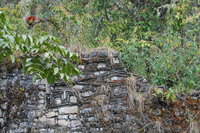
Out of Leimebamba, we hiked to La Congona, a settlement situated spectacularly on top of a local mountain. The path winds up through countryside still farmed as it has been for hundreds of years. We saw people working with horses and donkeys and assorted farm animals running wild on the path. Eventually we arrived at a small homestead where the alarm cow detected us and started making appropriate cow noises. At this point, various family members came out to ask for money. It turns out that La Congona is on their land and we had to pay to visit. The settlement is now only a ruin and overgrown with all sorts of cloud forest stuff. It was built by the Chachapoyas (People of the Clouds) some time between 500AD and 1493AD - they are good these archaeologists! A characteristic of the houses is that they are round. They also have patterns built into the walls by the use of different shaped stones. It was fun scrambling through the forest discovering new ruins at each turn. The views were spectacular too. Since we are now between desert and rain forest, the climate is quite temperate (although strictly cloud forest). We marvelled at how like the UK this scenery is. As long as you don't look at the huge mountains in the distance or think about the 3000m altitude, you could easily be in Yorkshire or the Peak District.
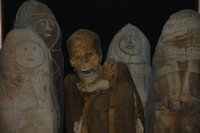
The next day we marvelled even more at how similar the scenery was to the UK as the cloud was down around our ankles and it was lashing it down with rain. A local chap informed us that it rained for two days every month exactly on the new moon - we did not have the time to stay and verify this. We trudged along the formerly dusty (now muddy) road to the rather excellent Leimebamba museum where we learned (in Spanish) all about the People of the Clouds. They did a lot of mummification and there is a large collection of these wrapped-up dead dudes on display together with many ceramic artefacts for Megan to lust over. The expressions on the mummies' faces reminded us of the bus journey over here. We also visited a local café that is a mecca for hummingbirds. Hundreds of them flitted around the sugar feeders and in the bushes. We had never seen them before so it was marginally interesting for a short while. The camera (Nikon D40) met its match here. The D700 and fast lenses sitting at home would have been perfect, but were way too heavy to lug around on this trip just for a small bird.
We had planned to take a bus to Chachapoyas, but inquiries in Leimebamba revealed that the only bus left at 4am. Further inquiries revealed that this was because the road was closed between 7am and 5pm. It would just have been too easy! These closures also meant that we may not have been able to visit the ruins of Kuélap out of Chachapoyas which was one of the reasons for coming up here.
We spoke to a mototaxi driver in Leimebamba who had a friend with a car. We spoke to the man with the car (who it turns out we had met the day before). Gonzalo agreed to take us at 6am which would be early enough to get through the roadworks. He would also take us to Kuélap on the way. He would then dump us in the small town of Tingo on the other side of the roadworks where we could spend the night and then press on to Chachapoyas. We did the sums and it made sense so we took him up on the offer.
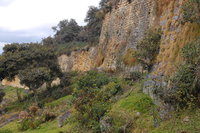
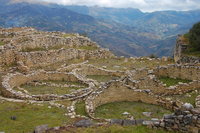
The route from Tingo to Kuélap is 37km of winding death road to which we are becoming quite inured. Plus Gonzalo was a very cautious driver which is unusual here, but quite refreshing. Kuélap was a large mountain-top citadel of the Chachapoyas people that was constructed around 800AD at about 3200m. It really is in the clouds much of the time, but fortunately for us the weather was pretty clear when we dropped by. There are large fortified external walls and masses of the characteristic round dwellings inside, together with some defensive towers and a temple. It is in a spectacular location a bit like Machu Picchu. In fact the place is sometimes known as the little Machu Picchu. It is much smaller in size and also in entry fee! Since we had come with a private driver, we pretty much had the place to ourselves whilst the tour buses tried to make the best of the road closures. They were arriving en mass as we were leaving. Always a good thing.
After Gonzalo left us in Tingo, we found that we could get a collectivo to Chachapoyas that afternoon. The only problem was that it would not leave until 4pm due to...you guessed it, some roadworks further up the road which had it closed until 5pm. At least the Peruvian workers are consistent! We took the collectivo and, after sitting at the side of the road swatting away mosquitoes for an hour and a half, the road opened and we proceeded without incident to Chachapoyas.
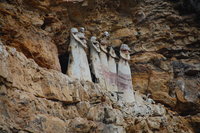
Again, it's ruins! The Chachapoyans revered their senior figures even after death. There are various reasons postulated as to why they chose to inter dead leaders in individual sarcophagi half way up vertical cliff faces, but this they did. The ones we visited at Karajía are quite famous as they are about 1200 years old and yet strangely intact considering they are made of straw and rocks and are perched hundreds of metres up an inaccessible cliff face. The local artesan wares are replete with minature models of these figures. Each sarcophagus is about person sized and contains the mummified remains of a single important dude. They gaze out over the valley to where the village was located. The village is no more as it was plundered for its stone many years ago. Yet again, the trip involved precipitous mountain tracks navigated at great speed in a small mini-bus whilst all our fellow Peruvian passengers slept soundly, oblivious to the near death experience.
We also tried to visit a site known as the City of the Dead, but this was not quite so successful. Apparently, the track we had to drive up was very muddy and susceptible to rain. The skies looked like rain so the guide decided we had to rush. This meant not waiting for the office to open that held the key needed to access the site. We drove for a couple of hours and then climbed down a cliff face for half an hour to get to the site. Inevitably, the site was securely locked and inaccessible. We decided to start the trek back up the cliff. The guide ran off back up to the van to get some tools to break in to the sacred site. By the time all this was over, the heavens had opened, we were back at the bus and the driver was nervously looking at his watch and peering down the path. Eventually, everyone clambered back up and we set off on the return journey only to immediately (and inevitably) become stuck in the mud! We had to push the mini-bus up the hill whilst the driver sat with his foot hard on the accelerator achieving absolutely nothing. Rather surprisingly, we did manage to push the bus out and actually made it safely down the mountain albeit in pitch darkness and often sideways.
A 9 hour, over-night bus trip (£12) took us from Chachapoyas to Chiclayo down on the coast. The route follows a winding river or two and climbs another Andean pass before descending to the Pacific coast. As a result, there was plenty of lurching and swaying en route, which does not lend itself to quality sleep. This time, the "in flight" film seemed to be about lorries and buses crashing! Yet again the Peruvians demonstrated their extraordinary knack of falling asleep as a sanity preservation mechanism (it seems to be triggered by any kind of motion). We arrived in the Chiclayo bus station at 4:30 am, which is not the best time to be anywhere having had no sleep.
Chiclayo is billed as a town with no tourist attractions, which seemed like a good enough reason to come here. What it does have in the surrounding area in spades is...you guessed it...ruins. These ruins are principally Moche which makes them about 1500 years old. Or maybe 1000, or 1900.
First though, it was time to check out the local speciality which is ceviche. We tried a large plate of ceviche mixto which contained pieces of an unidentified white fish, octopus, squid, prawns, scallops and a whole crab. The key factor here, of course, is that it is all raw! The whole lot is marinated in the juice of citrus fruits which, apparently, cooks by oxidisation. Certainly it was all very tender and rather tasty in a seafood sort of way. Of particular note is that no sickness ensued. Quite remarkable really and not something that can be said for all Peruvian foodstuffs - even the cooked ones.
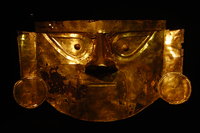
Outside town is the archaeological wonder that is Sipán. The site was discovered first by looters who began to sell on the black market the amazing artefacts they found. Eventually, this came to the notice of a local archaeologist. He managed to find out where the stuff was coming from and, with the help of the local police, secured the site to prevent further plundering. Subsequent excavations revealed an amazing royal Moche burial site containing an important leader who became known as El Señor de Sipán (Lord of Sipán). The burial site is more than 1500 years old and contains a myriad of gold, silver and copper artefacts.
We took a local combi-bus the 6 miles (30p) to the town of Lambayeque. Here there are two excellent museums, the Museo Tumbas Reales de Sipán and the Museo Regional Arqueológico Enrique Brüning. Both contain countless artefacts from the local cultures over the centuries, but the former houses the artefacts (and skeletal remains) excavated from the Sipán site.
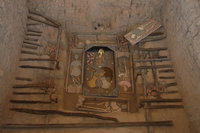
The next day, we took a local bus the 20 miles (70p) to the site of the Sipán pyramid and excavations. This was proper Peruvian bus travel. We had to sit on the floor amid sacks of unidentified stuff and barrels of petrol. Apropos dead people, on the way we passed the Chiclayo Hospital. Disturbingly, clouds of thick black smoke were coming out of the hospital chimney. More disturbing was the row of undertakers' shops right outside the gate. Even more disturbing was the row of vultures sitting on the roof looking down on the proceedings.
The Sipán pyramid complex is another adobe brick construction and yet again the local museum told us breathlessly about the excellent archaeological work that goes on. Yet again, large quantities of the site have washed away due to El Niño. It is possible to see where El Señor de Sipán was found and a rather impressive recreation of the burial site is now on show.
Chiclayo has turned out to be a bit of an irritating place in some respects. Maybe we are just getting a bit tired of the Peruvian mentality. They have developed another stunning traffic protocol here. Like all cities here, this one is built on the standard grid pattern. This means there are many, many crossroads. However, they have not thought to mandate any kind of protocol for how to navigate these junctions. As a result, it's a complete free for all with cars pushing and barging to try and get across. Of course, the mandatory, incessant blowing of horns is ever present and is, as usual, completely pointless. The hazards to the pedestrian are enormous. Presumably, give-way lines would conflict with the Peruvian macho! As a result, the place is clogged with traffic and incredibly noisy all the time. Did we mention the entire town stinks of raw sewerage too? Time to move on.
We are now returning to Lima to embark on the last leg of the trip which is 10 days in the depths of the Amazon on the river somewhere. Likely we will be out of Internet range for most if not all of that time so, for those of you who have been curious about the lack of blog entries, the Amazon episode will likely be published at the end of August when we return to Lima prior to the flight home.
